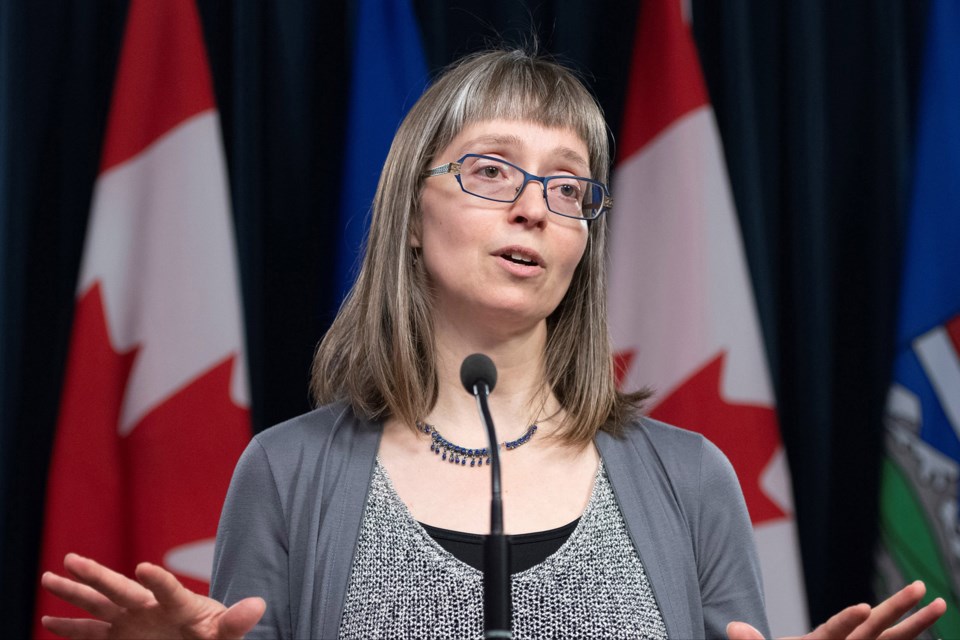ALBERTA – A woman in her 80s has become the second COVID-19 coronavirus death in Alberta.
The province's Chief Medical Officer of Health Dr. Deena Hinshaw made the announcement on Tuesday (March 24) and said the death appeared to be a result of community transmission.
The woman was a resident of the McKenzie Towne Continuing Care Centre in Calgary and had no history of travel.
“News of this death and other potential infections in a long-term care facility will be distressing for many people,” Hinshaw said.
“We are doing everything we can to limit cases of critical illness and death from this serious virus.”
The province reported 57 new cases of the virus bringing the total number of confirmed cases in Alberta to 358 as of Tuesday. Of those who are confirmed to have COVID-19, 28 are suspected to be a result of community transmission, 19 have been hospitalized, seven are in an intensive care unit and three have fully recovered.
One staff member with no travel history at the McKenzie Towne Continuing Care Centre and two residents of the facility have also tested positive for COVID-19. An additional 11 residents are showing symptoms of the virus. The testing of the residents is pending, Hinshaw said, adding that an investigation is taking place to determine the source of the virus.
The McKenzie Towne Continuing Care Centre staff member did not work while symptomatic. Hinshaw added that the centre has space for 150 residents in the part of the facility that has been impacted.
This case is concerning, she said because the continuing care is home to residents that require more care, are older, have multiple medical conditions and more prone to illness putting them at higher risk of severe outcomes if they are exposed to COVID-19. In addition, the close group settings in the centre have the potential to increase the spread of the virus.
“Long-term care is the setting where we have the highest vulnerability,” Hinshaw said, explaining why the provincial government has pushed aggressive measures to prevent the spread of the virus.
These actions include restrictions on mass gatherings, limiting the number of visitors to health facilities, the closure of public recreation facilities and limits on restaurant capacities to limit exposure to the virus.
“We are doing everything we possibly can to limit the introduction of infection and limit spread if it should get into one of these facilities,” Hinshaw said.
Hinshaw reiterated during the daily briefing that most people who are infected with COVID-19 will experience mild symptoms, and this makes following public health measures critical. She added that the province is exploring additional measures that could be put in place to help prevent the virus from spreading further.
“We will take all steps necessary to protect Albertans' health,” Hinshaw said.
“I know that this is scary, but we will get through this. This isn’t just about the actions that the government is taking, it’s down to each and every one of us.”
It is critical to continue to practising social distancing of two metres, Hinshaw said, to help slow the spread of COVID-19 in the province. She added that self-isolation remains paramount as well.
Hinshaw said that if someone experiences a cough, fever, shortness of breath, runny nose or sore through, symptoms associated with COVID-19, it is critical to stay home and not go to the doctor’s office, clinic or hospital unless symptoms are of an urgent nature.
If one is concerned, a COVID-19 self-assessment tool is available online at alberta.ca/covid19. If instructed by the website call Health Link at 811.
Albertans who have been travelled internationally are required to stay home and self-isolate for a 14-day period, even if they are feeling well. This practice is also required of people who come in close contact with returning travellers, Hinshaw said. If symptoms appear self-isolation is required for 10 days, or until symptoms are gone.
“All of these measures are critical to keep ourselves and each other safe and healthy,” Hinshaw said. “It is critical to immediately self-isolate at the first sign of symptoms.”
Hinshaw noted that the vast majority of cases in the province to date have been recorded in people who are returning to the province from outside the country, or their close contacts.
She explained that when looking at the rate of infection in the province it is important to note that Alberta has been doing more testing per capita in comparison to other provinces in the country. She added that other provinces have shifted the testing towards non-travellers sooner than Alberta. Because of this, Hinshaw said she would caution comparisons on infections rates between provinces.
As tests are shifted towards health care workers, it will help her team to understand what is happening within the province, not just what is being brought in from outside. The total number of infected health care workers is not currently available, Hinshaw said, but steps are being taken to make this data available.
She said the current trajectory of COVID-19 infection rates in the province are being studied, but cautioned the virus will not peak for at least a couple weeks.
“We know that we will not be finished this epidemic within the next few weeks. It will persist for several months,” Hinshaw said.
Follow RMOToday.com's COVID-19 special section for the latest local and national news on the coronavirus pandemic, as well as resources, FAQs and more.








